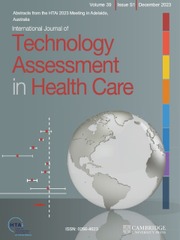No CrossRef data available.
Article contents
OP51 Thrombectomy In France: A National Use Of European Network for Health Technology Assessment (EUnetHTA) Joint Assessment
Published online by Cambridge University Press: 12 January 2018
Abstract
Mechanical thrombectomy (MT) is used in patients with acute ischaemic stroke due to occlusion of a proximal cerebral artery. Over the years endovascular techniques have been used to re-canalise blocked vessels, but are not currently reimbursed by National Health Insurance in France.
The aim was to assess the efficacy and safety of MT in combination with intravenous tissue plasminogen activator (IV t-PA), or as an alternative to it, in adults with an acute ischaemic stroke who are not eligible for thrombolysis or in whom thrombolysis has failed; to support the reimbursement decision by National Health Insurance.
Within the scope of The European Network for Health Technology Assessment (EUnetHTA), a rapid assessment of “Endovascular therapy using devices for acute ischaemic stroke” was jointly produced with Haute Autorité de santé (HAS) as a reviewer.
The EUnetHTA report provided a systematic review based on eight randomized controlled trials (RCT) for effectiveness and all available published data for safety.
To produce its assessment, HAS has adapted the EUnetHTA report by:
1. Updating the systematic literature review including the latest published trials
2. Retaining the subgroup analysis of the five most recent trials considered more relevant in the EUnetHTA report for the assessment of effectiveness
3. Analysing specifically the different endovascular interventions studied in the five RCTs
4. Taking into account contributions from stakeholders.
This horizontal collaboration among European HTA doers has facilitated and shortened the assessment of the clinical benefit of this technology, confirming the relevance of EUnetHTA cooperation.
This clinical assessment of thrombectomy is to be completed by the evaluation of its organizational impact in the management of acute ischemic stroke.
- Type
- Oral Presentations
- Information
- Copyright
- Copyright © Cambridge University Press 2018


